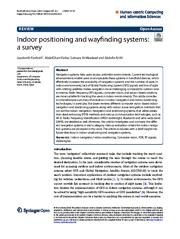Indoor positioning and wayfinding systems: a survey
Jayakanth Kunhoth, AbdelGhani Karkar, Somaya Al-Maadeed, Abdulla Al-Ali
2020
Human-Centric Computing and Information Sciences
Introduction The term 'navigation' collectively represent tasks that include tracking the user's position, planning feasible routes and guiding the user through the routes to reach the desired destination. In the past, considerable number of navigation systems were developed for accessing outdoor and indoor environments. Most of the outdoor navigation systems adopt GPS and Global Navigation Satellite System (GLONASS) to track the user's position. Important applications of outdoor navigation
more »
... ems include wayfinding for vehicles, pedestrians, and blind people [1, 2] . In indoor environments, the GPS cannot provide fair accuracy in tracking due to nonline of sight issues [3] . This limitation hinders the implementation of GPS in indoor navigation systems, although it can be solved by using "high-sensitivity GPS receivers or GPS pseudolites" [4] . However, the cost of implementation can be a barrier to applying this system in real-world scenarios. Abstract Navigation systems help users access unfamiliar environments. Current technological advancements enable users to encapsulate these systems in handheld devices, which effectively increases the popularity of navigation systems and the number of users. In indoor environments, lack of Global Positioning System (GPS) signals and line of sight with orbiting satellites makes navigation more challenging compared to outdoor environments. Radio frequency (RF) signals, computer vision, and sensor-based solutions are more suitable for tracking the users in indoor environments. This article provides a comprehensive summary of evolution in indoor navigation and indoor positioning technologies. In particular, the paper reviews different computer vision-based indoor navigation and positioning systems along with indoor scene recognition methods that can aid the indoor navigation. Navigation and positioning systems that utilize pedestrian dead reckoning (PDR) methods and various communication technologies, such as Wi-Fi, Radio Frequency Identification (RFID) visible light, Bluetooth and ultra-wide band (UWB), are detailed as well. Moreover, this article investigates and contrasts the different navigation systems in each category. Various evaluation criteria for indoor navigation systems are proposed in this work. The article concludes with a brief insight into future directions in indoor positioning and navigation systems.
doi:10.1186/s13673-020-00222-0
fatcat:m7lt5zdcjbbsvlh7fwatjvpx6y

